Achievement of a Parameter Window for the Selective Laser Melting Formation of a GH3625 Alloy
Abstract
1. Introduction
2. Numerical Simulation
2.1. Powder Bed Modeling in Mesoscopic Model
2.2. Fluid Dynamics Modeling in the Mesoscopic Model
2.2.1. Heat Transfer and Fluid Flow Equations
2.2.2. Boundary Condition
2.2.3. CFD Model for SLM Process
2.3. Mesoscopic Model Setup
3. Evolution of Molten Pool Morphology during Single Molten Track Forming
3.1. Experimental Validation
3.2. Forming Mechanism of the Molten Pool
3.3. Evolution Process of Molten Pool
4. Relationship between Process Parameters and Molten Pool Morphology
4.1. The Effect of Scanning Speed
4.2. The Effect of Laser Power
4.3. Window of Processing Parameters
5. Conclusions
Author Contributions
Funding
Institutional Review Board Statement
Informed Consent Statement
Data Availability Statement
Conflicts of Interest
References
- Chen, F.; Wang, Q.; Zhang, C.; Huang, Z.; Jia, M.; Shen, Q. Microstructures and mechanical behaviors of additive manufactured Inconel 625 alloys via selective laser melting and laser engineered net shaping. J. Alloys Compd. 2022, 917, 165572. [Google Scholar] [CrossRef]
- Gao, J.; Ma, Q.; Sun, Y.; Wang, K.; Song, Q.; Wang, C. Effect of Nb content on microstructure and corrosion resistance of Inconel 625 coating formed by laser cladding. Surf. Coat. Technol. 2023, 458, 129311. [Google Scholar] [CrossRef]
- Zhang, C.; Chen, F.; Wang, Q.; Liu, Y.; Shen, Q.; Zhang, L. Additive manufacturing and mechanical properties of TC4/Inconel 625 functionally graded materials by laser engineered net shaping. Mater. Sci. Eng. A-Struct. Mater. Prop. Microstruct. Process. 2023, 862, 144370. [Google Scholar] [CrossRef]
- Du, K.; Yang, L.; Xu, C.; Wang, B.; Gao, Y. High Strain Rate Yielding of Additive Manufacturing Inconel 625 by Selective Laser Melting. Materials 2021, 14, 5408. [Google Scholar] [CrossRef]
- Wang, L.; Wei, Q.; Shi, Y.; Liu, J.; He, W. Experimental Investigation into the Single-track of Selective Laser Melting of IN625. In Proceedings of the International Conference on Chemical Engineering and Advanced Materials, Changsha, China, 28–30 May 2011; pp. 2844–2848. [Google Scholar]
- Yadroitsev, I.; Gusarov, A.; Yadroitsava, I.; Smurov, I. Single track formation in selective laser melting of metal powders. J. Mater. Process. Technol. 2010, 210, 1624–1631. [Google Scholar] [CrossRef]
- Yadroitsev, I.; Yadroitsava, I.; Bertrand, P.; Smurov, I. Factor analysis of selective laser melting process parameters and geometrical characteristics of synthesized single tracks. Rapid Prototyp. J. 2012, 18, 201–208. [Google Scholar] [CrossRef]
- King, W.E.; Barth, H.D.; Castillo, V.M.; Gallegos, G.F.; Gibbs, J.W.; Hahn, D.E.; Kamath, C.; Rubenchik, A.M. Observation of keyhole-mode laser melting in laser powder-bed fusion additive manufacturing. J. Mater. Process. Technol. 2014, 214, 2915–2925. [Google Scholar] [CrossRef]
- Dilip, J.J.S.; Zhang, S.; Teng, C.; Zeng, K.; Robinson, C.; Pal, D.; Stucker, B. Influence of processing parameters on the evolution of melt pool, porosity, and microstructures in Ti-6Al-4V alloy parts fabricated by selective laser melting. Prog. Addit. Manuf. 2017, 2, 157–167. [Google Scholar] [CrossRef]
- Yang, J.; Han, J.; Yu, H.; Yin, J.; Gao, M.; Wang, Z.; Zeng, X. Role of molten pool mode on formability, microstructure and mechanical properties of selective laser melted Ti-6A1-4V alloy. Mater. Des. 2016, 110, 558–570. [Google Scholar] [CrossRef]
- Promoppatum, P.; Yao, S.-C. Analytical evaluation of defect generation for selective laser melting of metals. Int. J. Adv. Manuf. Technol. 2019, 103, 1185–1198. [Google Scholar] [CrossRef]
- Kamath, C.; El-dasher, B.; Gallegos, G.F.; King, W.E.; Sisto, A. Density of additively-manufactured, 316L SS parts using laser powder-bed fusion at powers up to 400 W. Int. J. Adv. Manuf. Technol. 2014, 74, 65–78. [Google Scholar] [CrossRef]
- Liu, S.; Liu, J.; Chen, J.; Liu, X. Influence of surface tension on the molten pool morphology in laser melting. Int. J. Therm. Sci. 2019, 146, 106075. [Google Scholar] [CrossRef]
- Yang, L.X.; Peng, X.F.; Wang, B.X. Numerical modeling and experimental investigation on the characteristics of molten pool during laser processing. Int. J. Heat Mass Transf. 2001, 44, 4465–4473. [Google Scholar] [CrossRef]
- Adjamsky, S.V.; Tkachev, Y.V.; Kononenko, G.A. Effect of Selective Laser Melting Parameters on the Melt Pool Formed by Single Tracks of the Heat-Resistant Inconel 718 Nickel Alloy. Powder Metall. Met. Ceram. 2021, 59, 592–600. [Google Scholar] [CrossRef]
- Raut, R.; Ball, A.K.; Basak, A. Impact of track length, track shape, and track location on thermal distortion in laser powder bed fusion of IN625: Single laser vs. three lasers. J. Eng. Res. 2023, in press. [CrossRef]
- He, Q.; Xia, H.; Liu, J.; Ao, X.; Lin, S. Modeling and numerical studies of selective laser melting: Multiphase flow, solidification and heat transfer. Mater. Des. 2020, 196, 109115. [Google Scholar] [CrossRef]
- Francois, M.M.; Sun, A.; King, W.E.; Henson, N.; Tourret, D.; Bronkhorst, C.A.; Carlson, N.N.; Newman, C.K.; Haut, T.; Bakosi, J.; et al. Modeling of additive manufacturing processes for metals: Challenges and opportunities. Curr. Opin. Solid State Mater. Sci. 2017, 21, 198–206. [Google Scholar] [CrossRef]
- Khairallah, S.A.; Anderson, A. Mesoscopic simulation model of selective laser melting of stainless steel powder. J. Mater. Process. Technol. 2014, 214, 2627–2636. [Google Scholar] [CrossRef]
- Verhaeghe, F.; Craeghs, T.; Heulens, J.; Pandelaers, L. A pragmatic model for selective laser melting with evaporation. Acta Mater. 2009, 57, 6006–6012. [Google Scholar] [CrossRef]
- Heeling, T.; Cloots, M.; Wegener, K. Melt pool simulation for the evaluation of process parameters in selective laser melting. Addit. Manuf. 2017, 14, 116–125. [Google Scholar] [CrossRef]
- Dai, D.; Gu, D. Effect of metal vaporization behavior on keyhole-mode surface morphology of selective laser melted composites using different protective atmospheres. Appl. Surf. Sci. 2015, 355, 310–319. [Google Scholar] [CrossRef]
- Zhang, T.; Li, H.; Liu, S.; Shen, S.; Xie, H.; Shi, W.; Zhang, G.; Shen, B.; Chen, L.; Xiao, B.; et al. Evolution of molten pool during selective laser melting of Ti–6Al–4V. J. Phys. D Appl. Phys. 2019, 52, 055302. [Google Scholar] [CrossRef]
- Zheng, M.; Wei, L.; Chen, J.; Zhang, Q.; Zhong, C.; Lin, X.; Huang, W. A novel method for the molten pool and porosity formation modelling in selective laser melting. Int. J. Heat Mass Transf. 2019, 140, 1091–1105. [Google Scholar] [CrossRef]
- Liu, D.; Pei, J.; Hou, H.; Niu, X.; Zhao, Y. Optimizing solidification dendrites and process parameters for laser powder bed fusion additive manufacturing of GH3536 superalloy by finite volume and phase-field method. J. Mater. Res. Technol.-JmrT 2023, 27, 3323–3338. [Google Scholar] [CrossRef]
- Lu, H.; Pan, J.; Gu, Y.; Hu, X.; Duan, Z.; Li, H. Effect of molten pool flow and recoil pressure on grain growth structures during laser powder bed fusion by an integrated model. Int. J. Heat Mass Transf. 2024, 223, 125219. [Google Scholar] [CrossRef]
- Azadi Tinat, M.R.; Uddagiri, M.; Steinbach, I.; Lopez-Galilea, I. Numerical Simulations to Predict the Melt Pool Dynamics and Heat Transfer during Single-Track Laser Melting of Ni-Based Superalloy (CMSX-4). Metals 2023, 13, 1091. [Google Scholar] [CrossRef]
- Hertz, H. Über die Berührung fester elastischer Körper. J. Reine Angew. Math. 1881, 92, 156–171. [Google Scholar]
- Mindlin, R.D.; Deresiewicz, H. Elastic Spheres in Contact under Varying Oblique Force. Trans. ASME J. Appl. Mech. 1953, 20, 327–344. [Google Scholar] [CrossRef]
- Ye, W.; Bao, J.; Lei, J.; Huang, Y.; Li, Z.; Li, P.; Zhang, Y. Multiphysics Modeling of Thermal Behavior of Commercial Pure Titanium Powder During Selective Laser Melting. Met. Mater. Int. 2022, 28, 282–296. [Google Scholar] [CrossRef]
- Lee, Y.S.; Zhang, W. Modeling of heat transfer, fluid flow and solidification microstructure of nickel-base superalloy fabricated by laser powder bed fusion. Addit. Manuf. 2016, 12, 178–188. [Google Scholar] [CrossRef]
- Hirt, C.W.; Nichols, B.D. Volume of fluid (VOF) method for the dynamics of free boundaries. J. Comput. Phys. 1981, 39, 201–225. [Google Scholar] [CrossRef]
- Cheng, B.; Li, X.; Tuffile, C.D.; Ilin, A.; Willeck, H.; Hartel, U. Modeling of single track scanning in selective LASER melting: Powder compaction effect. In Proceedings of the 2018 International Solid Freeform Fabrication Symposium, Austin, TX, USA, 13–15 August 2018. [Google Scholar]
- Wu, Y.-C.; San, C.-H.; Chang, C.-H.; Lin, H.-J.; Marwan, R.; Baba, S.; Hwang, W.-S. Numerical modeling of melt-pool behavior in selective laser melting with random powder distribution and experimental validation. J. Mater. Process. Technol. 2018, 254, 72–78. [Google Scholar] [CrossRef]
- Hyun Min, C.; Lim, Y.C.; Farson, D. Simulation of weld pool dynamics in the stationary pulsed gas metal arc welding process and final weld shape. Weld. J. 2006, 85, 271s–283s. [Google Scholar]
- Sahoo, P.; Debroy, T.; McNallan, M.J. Surface Tension of Binary Metal Surface Active Solute Systems Under Conditions Relevant to Welding Metallurgy. Metall. Mater. Trans. B 1988, 19, 483–491. [Google Scholar] [CrossRef]
- Semak, V.; Matsunawa, A. The Role of Recoil Pressure in Energy Balance During Laser Materials Processing. J. Phys. D Appl. Phys. 1998, 30, 2541–2552. [Google Scholar] [CrossRef]
- Dai, D.; Gu, D. Thermal behavior and densification mechanism during selective laser melting of copper matrix composites: Simulation and experiments. Mater. Des. 2014, 55, 482–491. [Google Scholar] [CrossRef]
- Ding, Y.; Yuan, X.; Guo, T.; Hu, Y. Phase field simulation of dendrite growth under convection. Acta Metall. Sin.-Engl. Lett. 2010, 23, 121–128. [Google Scholar] [CrossRef]
- Ang, L.K.; Lau, Y.-Y.; Gilgenbach, R.M.; Spindler, H. Analysis of laser absorption on a rough metal surface. Appl. Phys. Lett. 1997, 70, 696–698. [Google Scholar] [CrossRef][Green Version]
- Stacy, S.C.; Zhang, X.; Pantoya, M.; Weeks, B. The effects of density on thermal conductivity and absorption coefficient for consolidated aluminum nanoparticles. Int. J. Heat Mass Transf. 2014, 73, 595–599. [Google Scholar] [CrossRef]
- Tian, Y.; Yang, L.; Zhao, D.; Huang, Y.; Pan, J. Numerical analysis of powder bed generation and single track forming for selective laser melting of SS316L stainless steel. J. Manuf. Process. 2020, 58, 964–974. [Google Scholar] [CrossRef]
- Cho, J.-H.; Farson, D.F.; Milewski, J.O.; Hollis, K.J. Weld pool flows during initial stages of keyhole formation in laser welding. J. Phys. D-Appl. Phys. 2009, 42, 175502. [Google Scholar] [CrossRef]
- Panwisawas, C.; Qiu, C.; Anderson, M.J.; Sovani, Y.; Turner, R.P.; Attallah, M.M.; Brooks, J.W.; Basoalto, H.C. Mesoscale modelling of selective laser melting: Thermal fluid dynamics and microstructural evolution. Comput. Mater. Sci 2017, 126, 479–490. [Google Scholar] [CrossRef]
- Chen, X.; Mu, W.; Xu, X.; Liu, W.; Huang, L.; Li, H. Numerical analysis of double track formation for selective laser melting of 316L stainless steel. Appl. Phys. A-Mater. Sci. Process. 2021, 127, 586. [Google Scholar] [CrossRef]
- Hager, A.; Kloss, C.; Pirker, S.; Goniva, C. Parallel resolved open source CFD-DEM: Method, validation and application. J. Comput. Multiph. Flows 2014, 6, 13–27. [Google Scholar] [CrossRef]
- Ma, Y.; Zhang, M.; Luo, H. Numerical and experimental studies of gas-liquid flow and pressure drop in multiphase pump valves. Sci. Prog. 2020, 103, 1–25. [Google Scholar] [CrossRef] [PubMed]
- Wang, J.; Fan, Y.; Ge, J.; Liu, X. The passive control on flow and heat transfer with streamwise micro grooves. Int. Commun. Heat Mass Transf. 2022, 135, 106065. [Google Scholar] [CrossRef]
- Ao, X.; Liu, J.; Xia, H.; Yang, Y. A Numerical Study on the Mesoscopic Characteristics of Ti-6Al-4V by Selective Laser Melting. Materials 2022, 15, 2850. [Google Scholar] [CrossRef]
- Jang, H.S.; Kim, S.H.; Park, G.-W.; Jeon, J.B.; Kim, D.; Kim, D.; Kim, W.R.; Choi, Y.S.; Shin, S. Process Parameter Optimization for Laser Powder Bed Fusion of Fe-Si Alloy Considering Surface Morphology and Track Width of Single Scan Track. Materials 2023, 16, 7626. [Google Scholar] [CrossRef] [PubMed]
- Ma, C.; Wei, X.; Yan, B.; Yan, P. Numerical Simulation of Moving Heat Flux during Selective Laser Melting of AlSi25 Alloy Powder. Metals 2020, 10, 877. [Google Scholar] [CrossRef]
- Bao, T.; Tan, Y.; Xu, Y. Mesoscopic Simulation of Core-Shell Composite Powder Materials by Selective Laser Melting. Materials 2023, 16, 7005. [Google Scholar] [CrossRef]
- Nie, S.; Li, L.; Wang, Q.; Zhao, R.; Lin, X.; Liu, F. Effects of Thermal Stress on the Formation and Cracking Behavior of Nickel-Based Superalloys by Selective Laser Melting Based on a Coupled Thermo-Mechanical Model. Materials 2022, 15, 8968. [Google Scholar] [CrossRef]
- Park, H.S.; Tran, N.H.; Nguyen, D.S. Development of a predictive system for SLM product quality. In Proceedings of the 5th International Conference on Modern Technologies in Industrial Engineering (ModTech), Lucian Blaga Univ Sibiu, Sibiu, Romania, 14–17 June 2017. [Google Scholar]
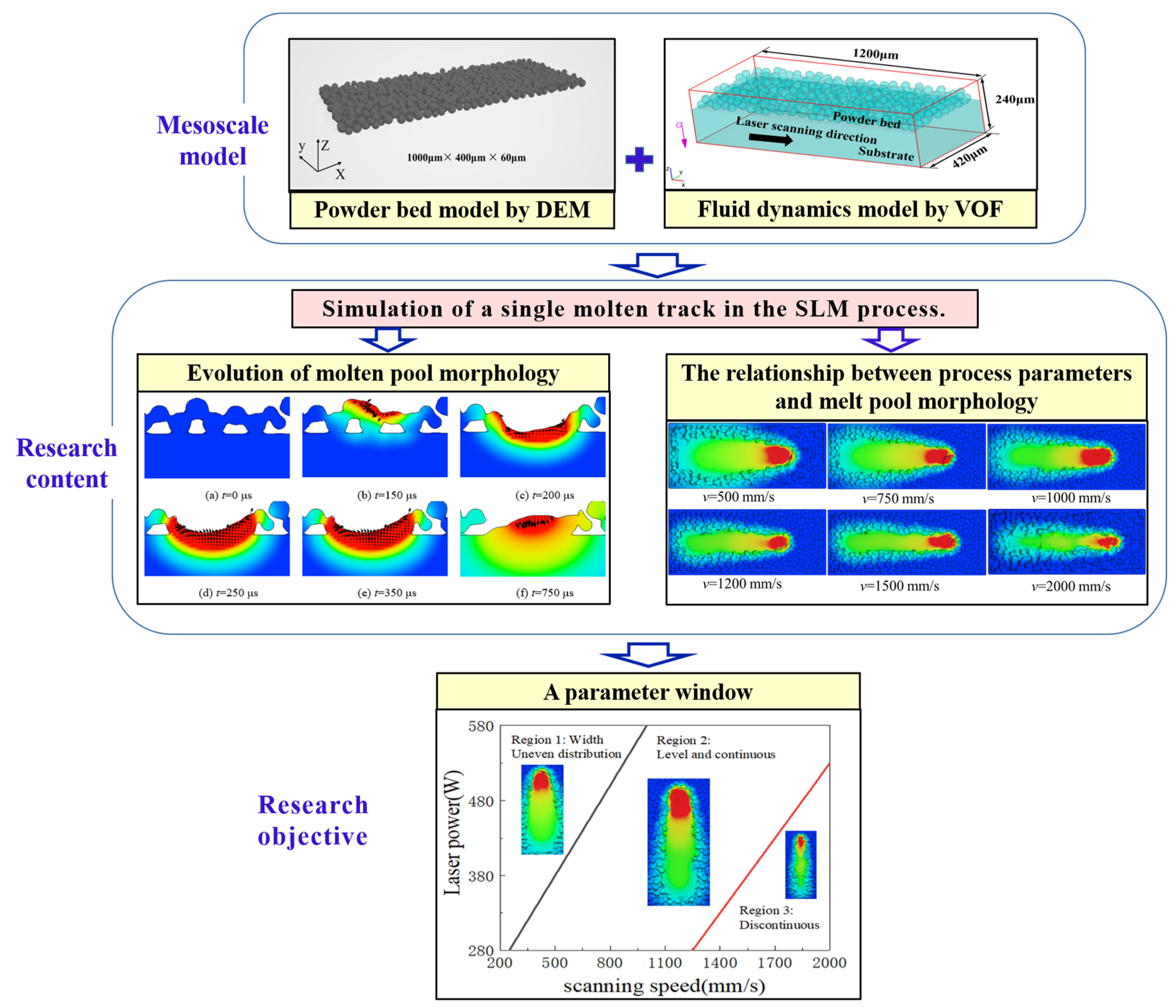
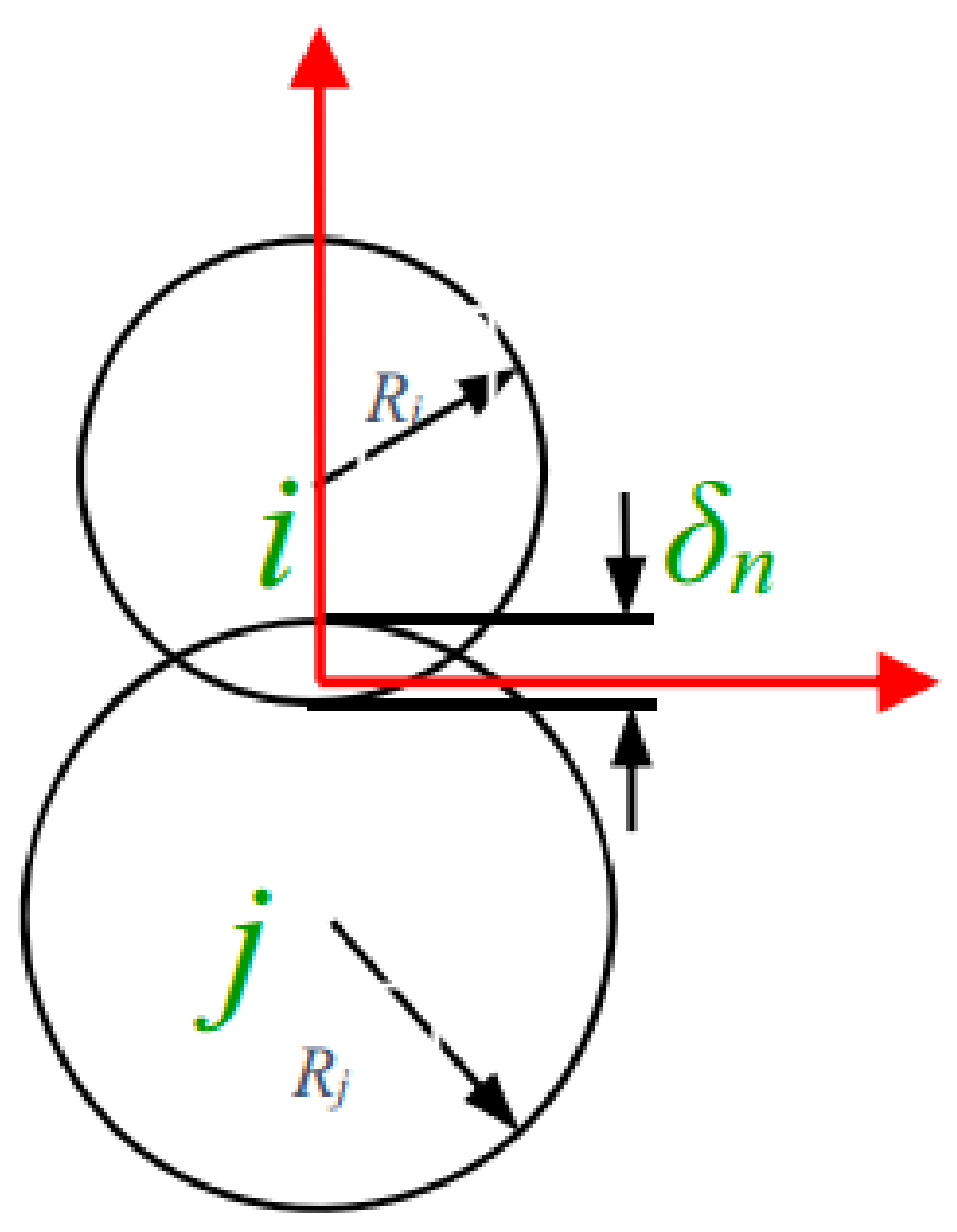
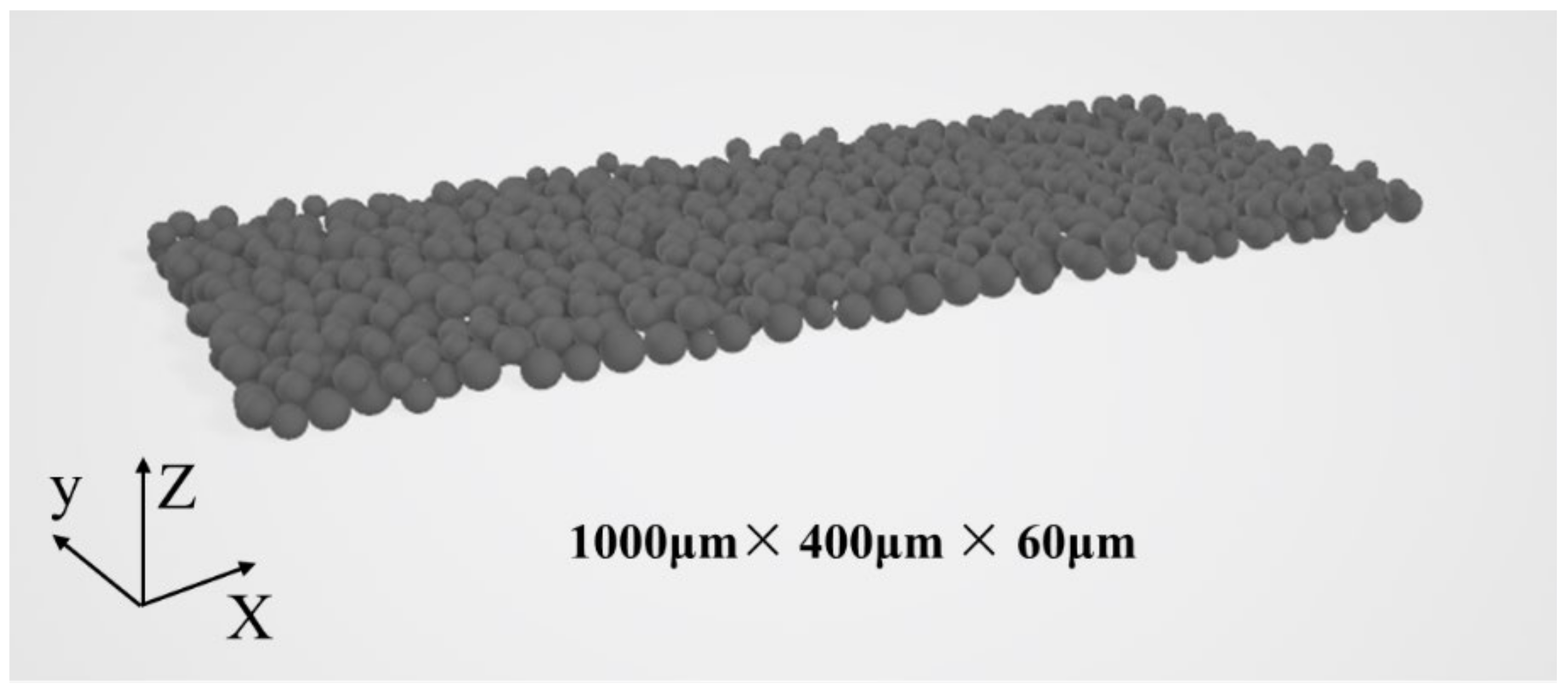

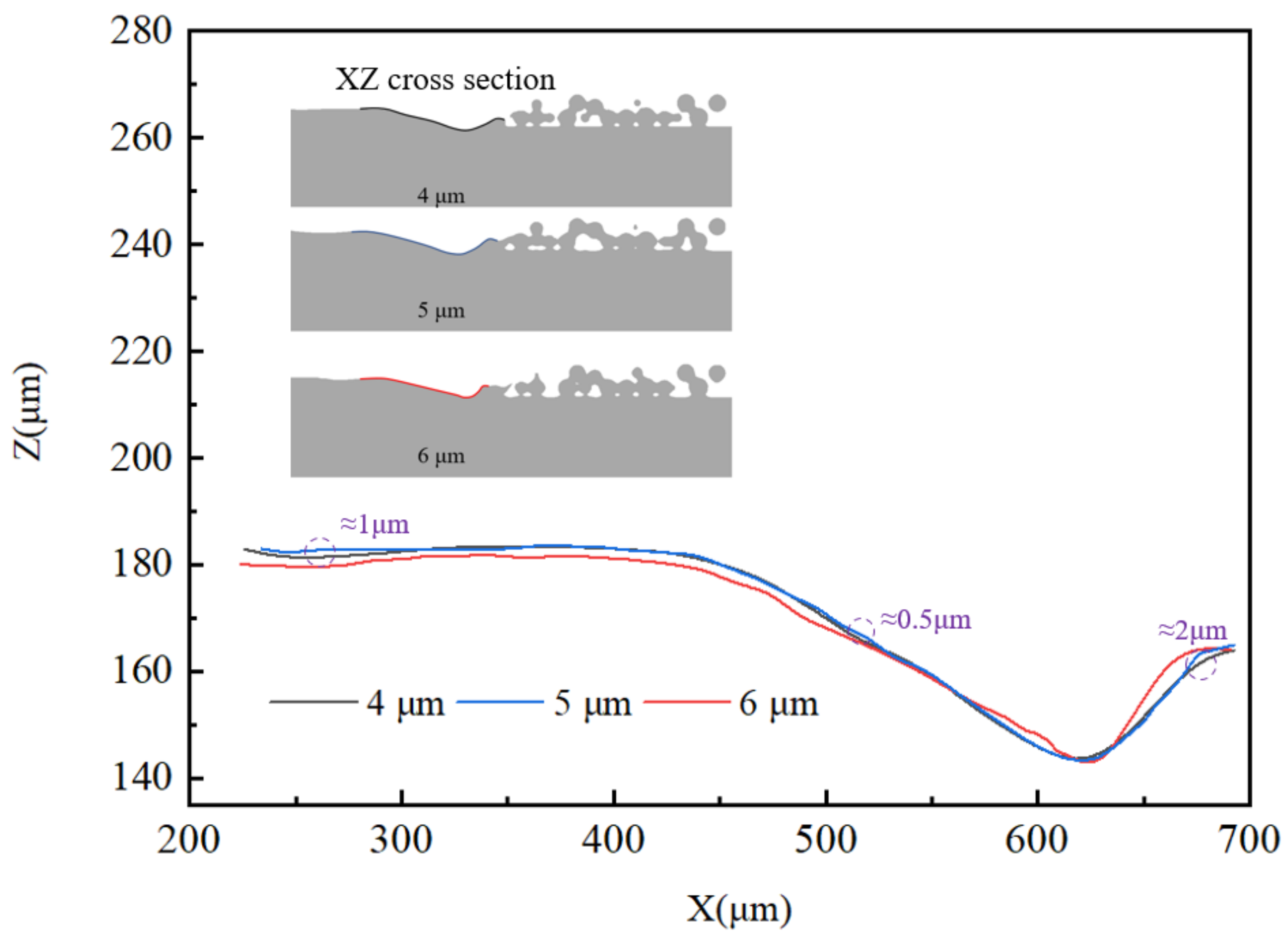
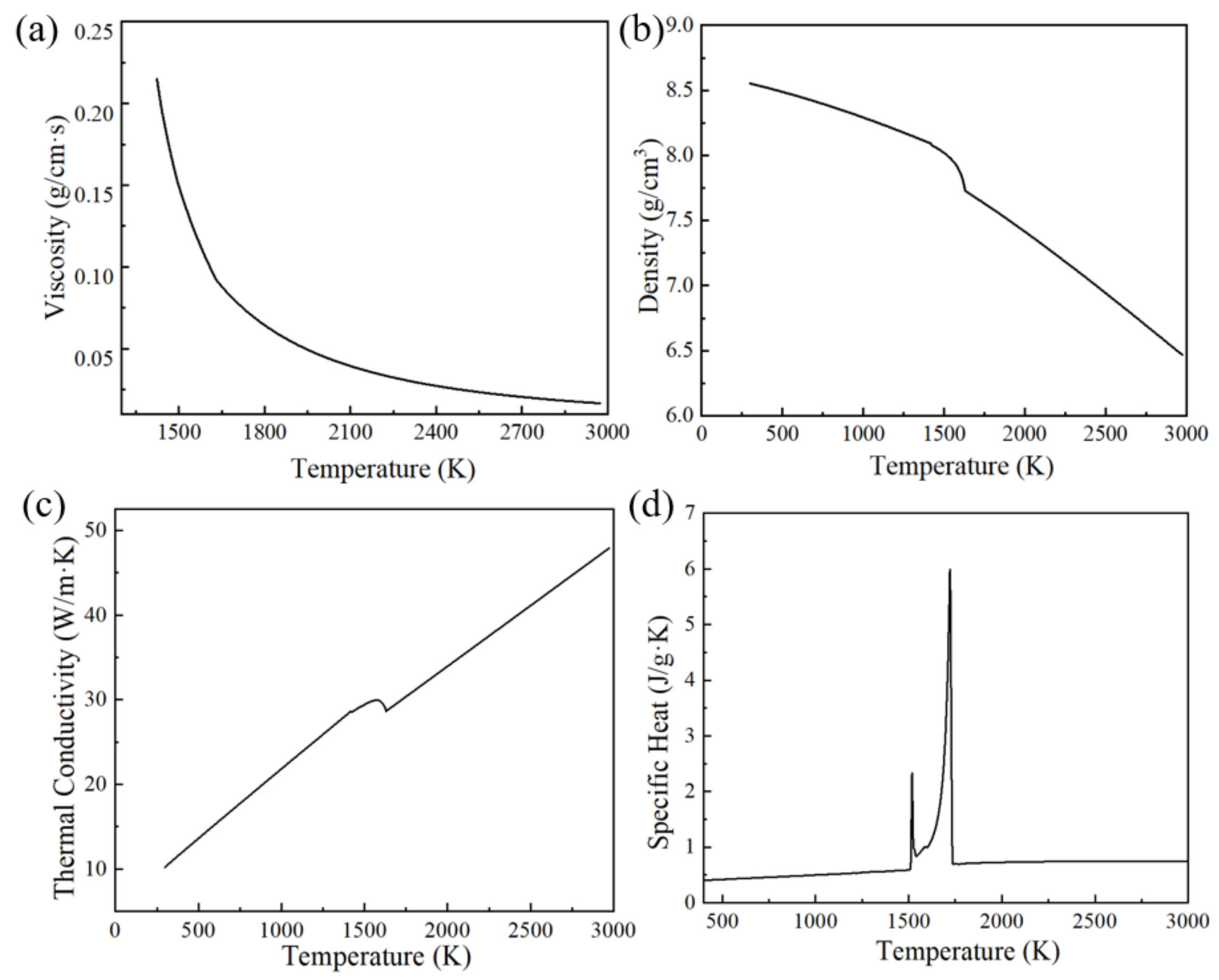

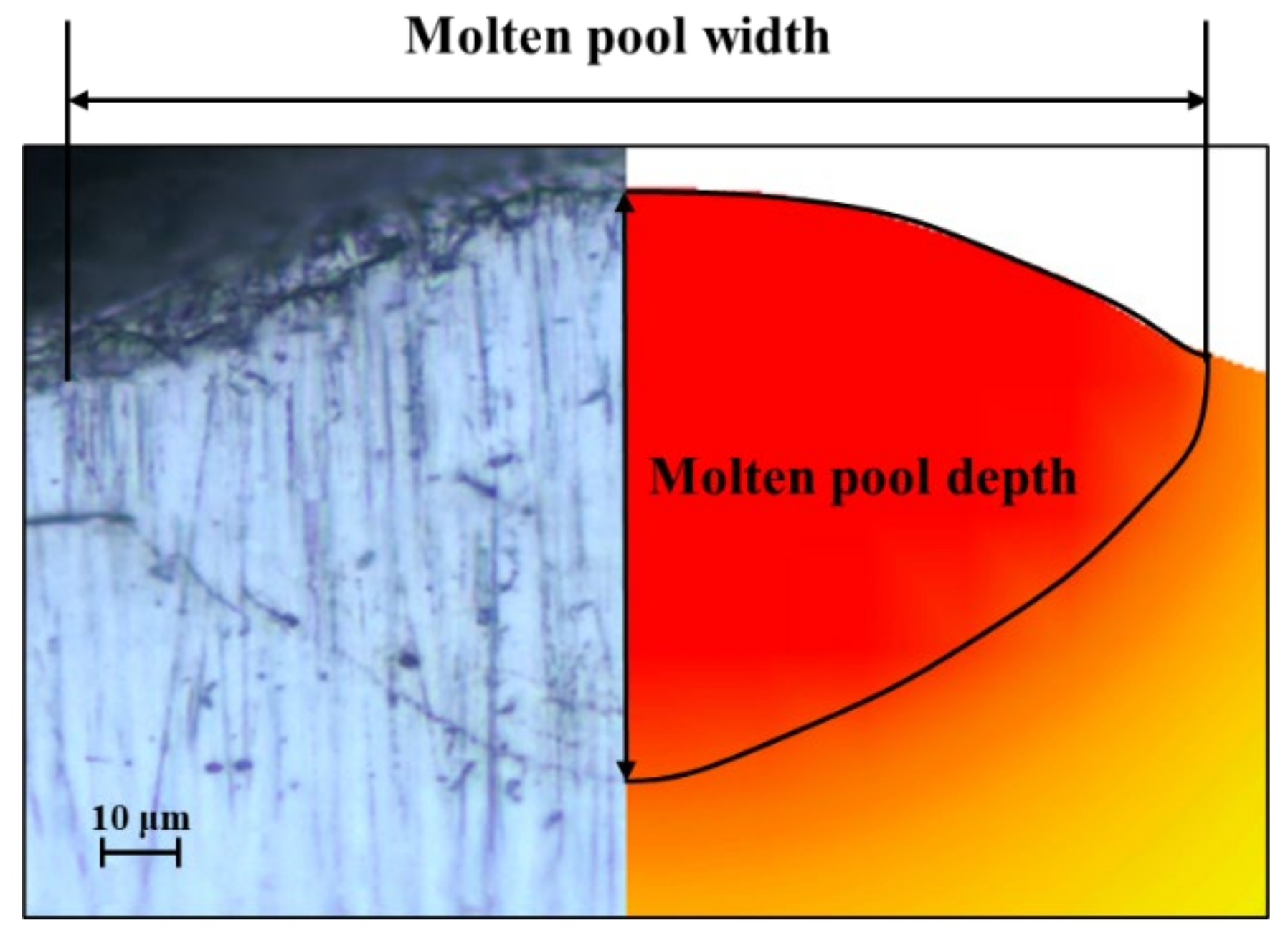

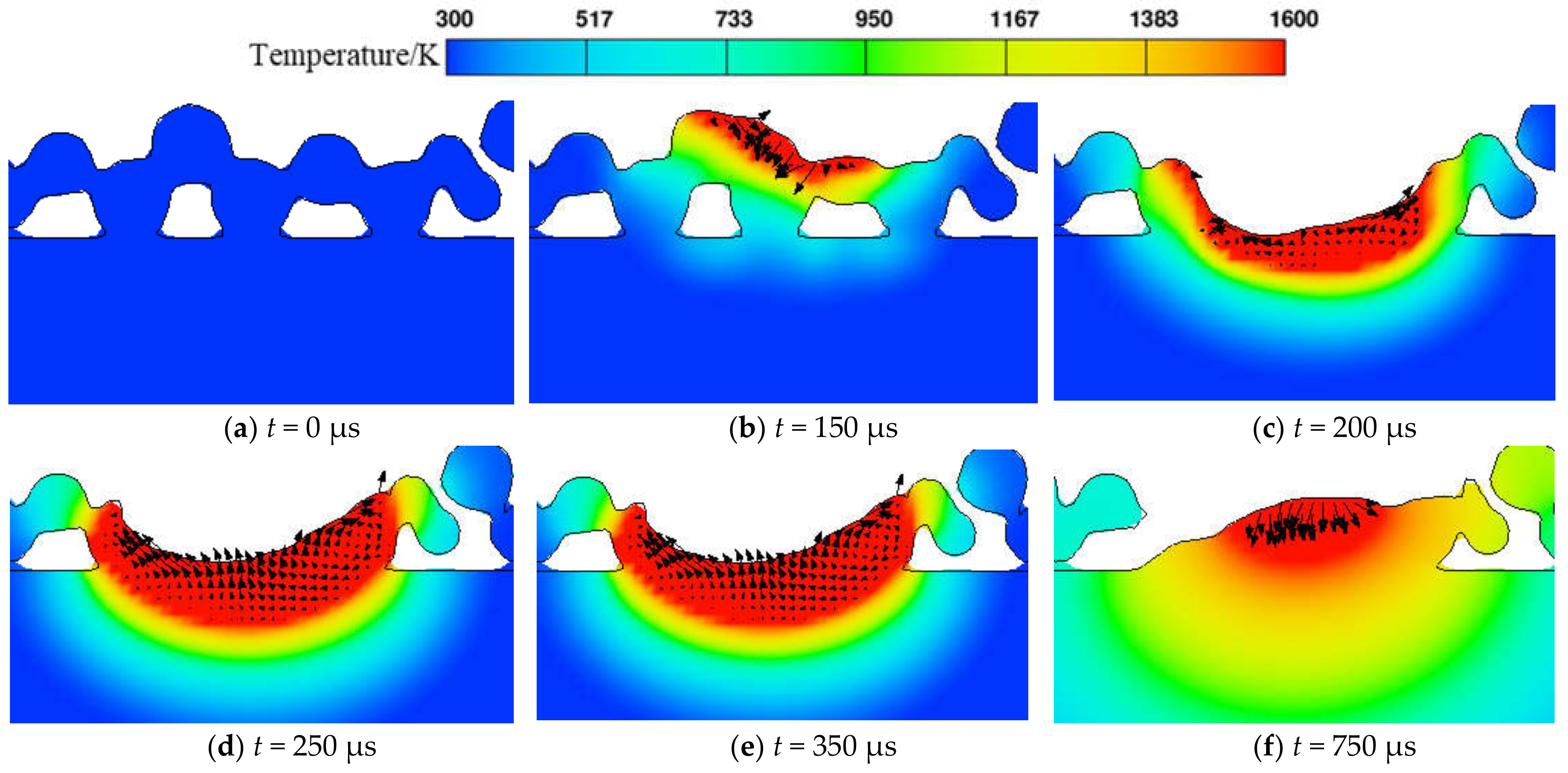
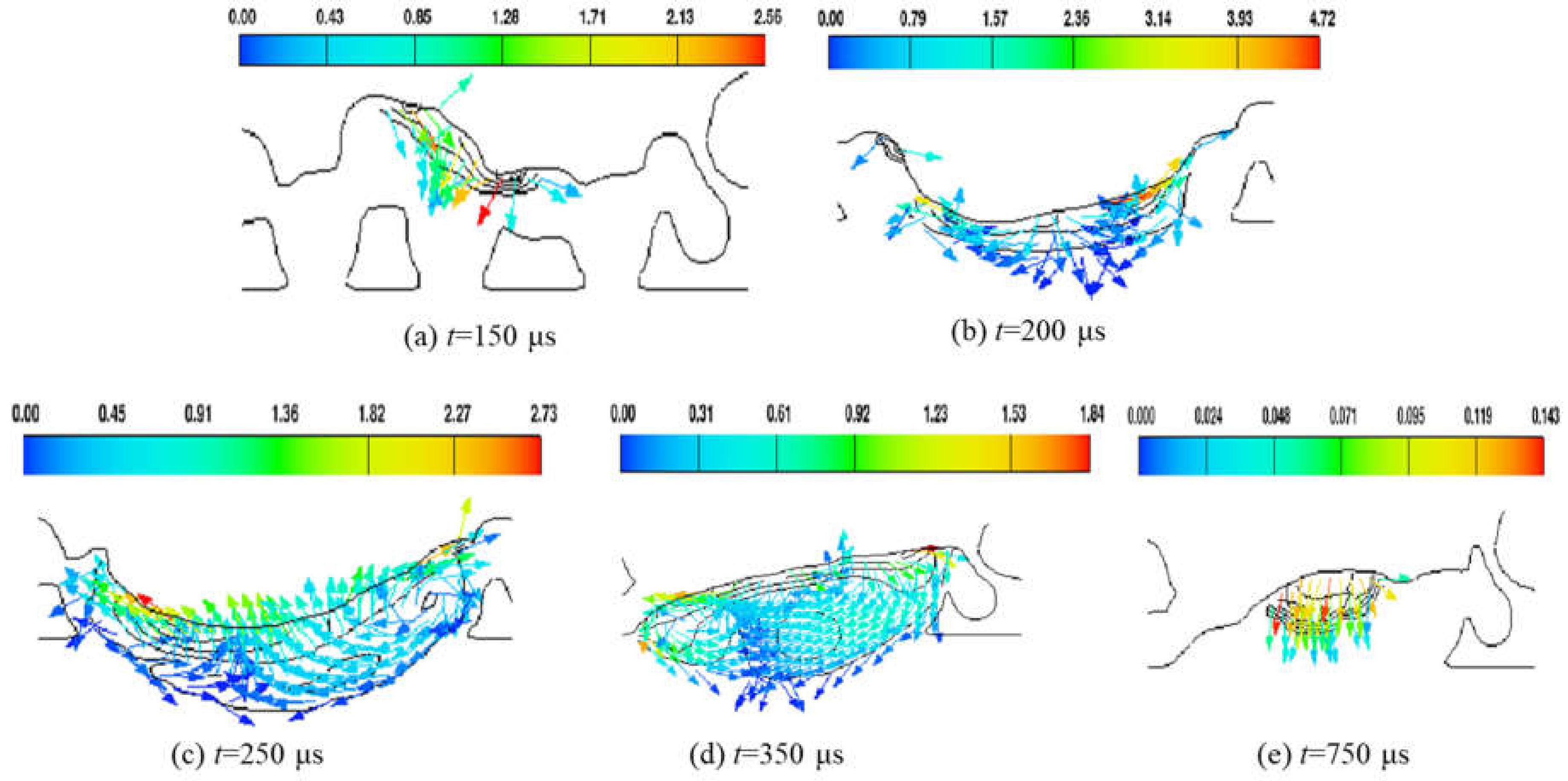
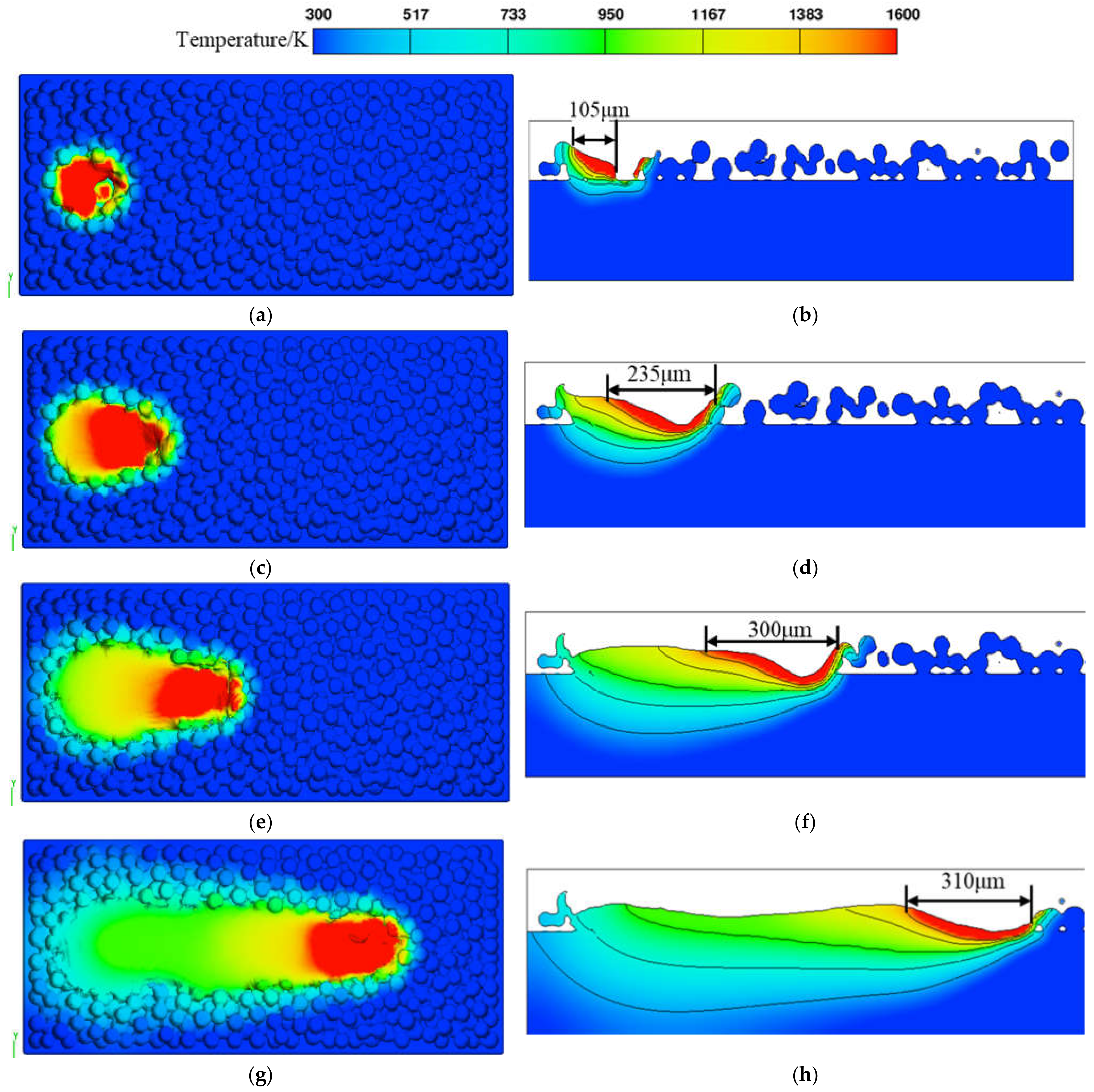

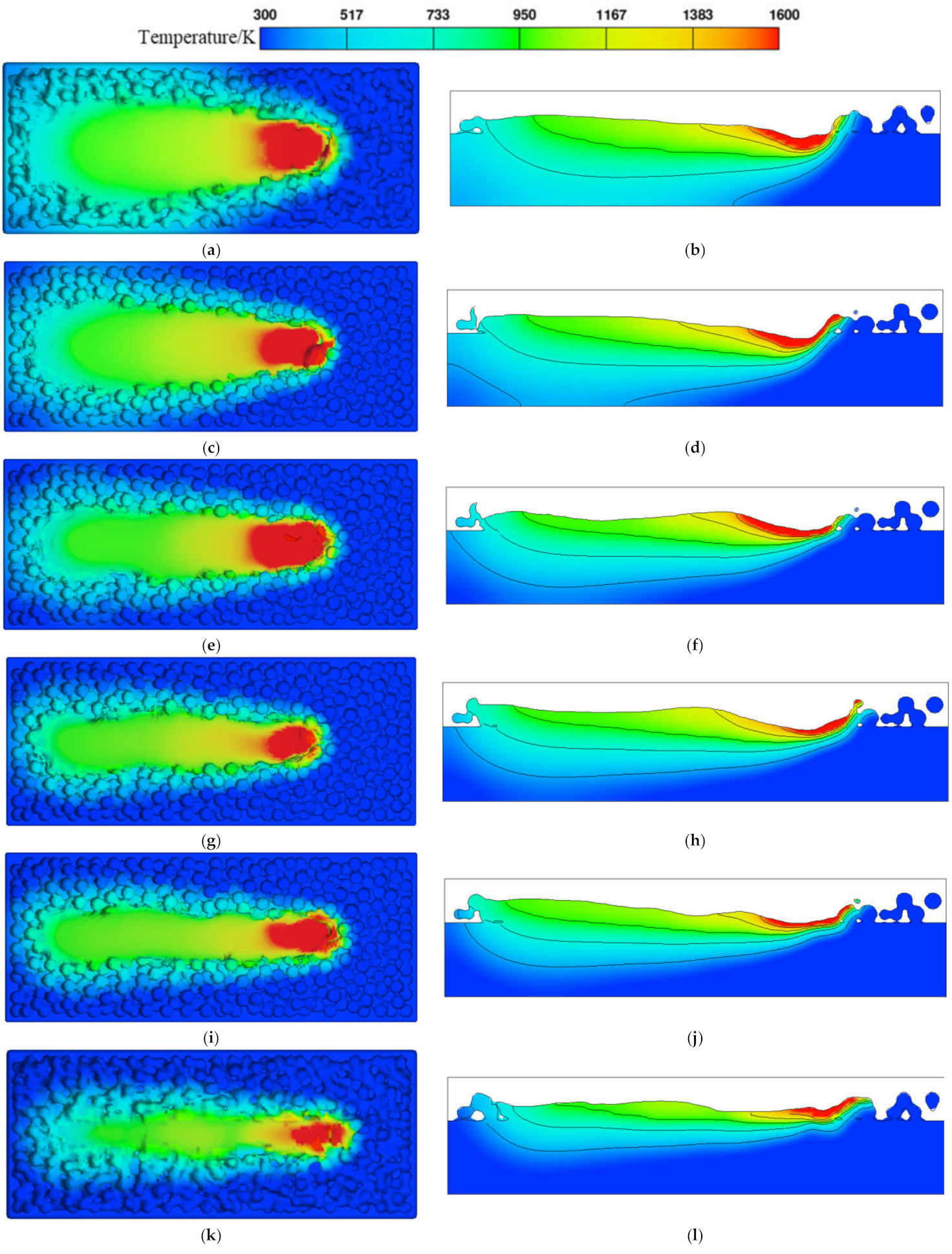

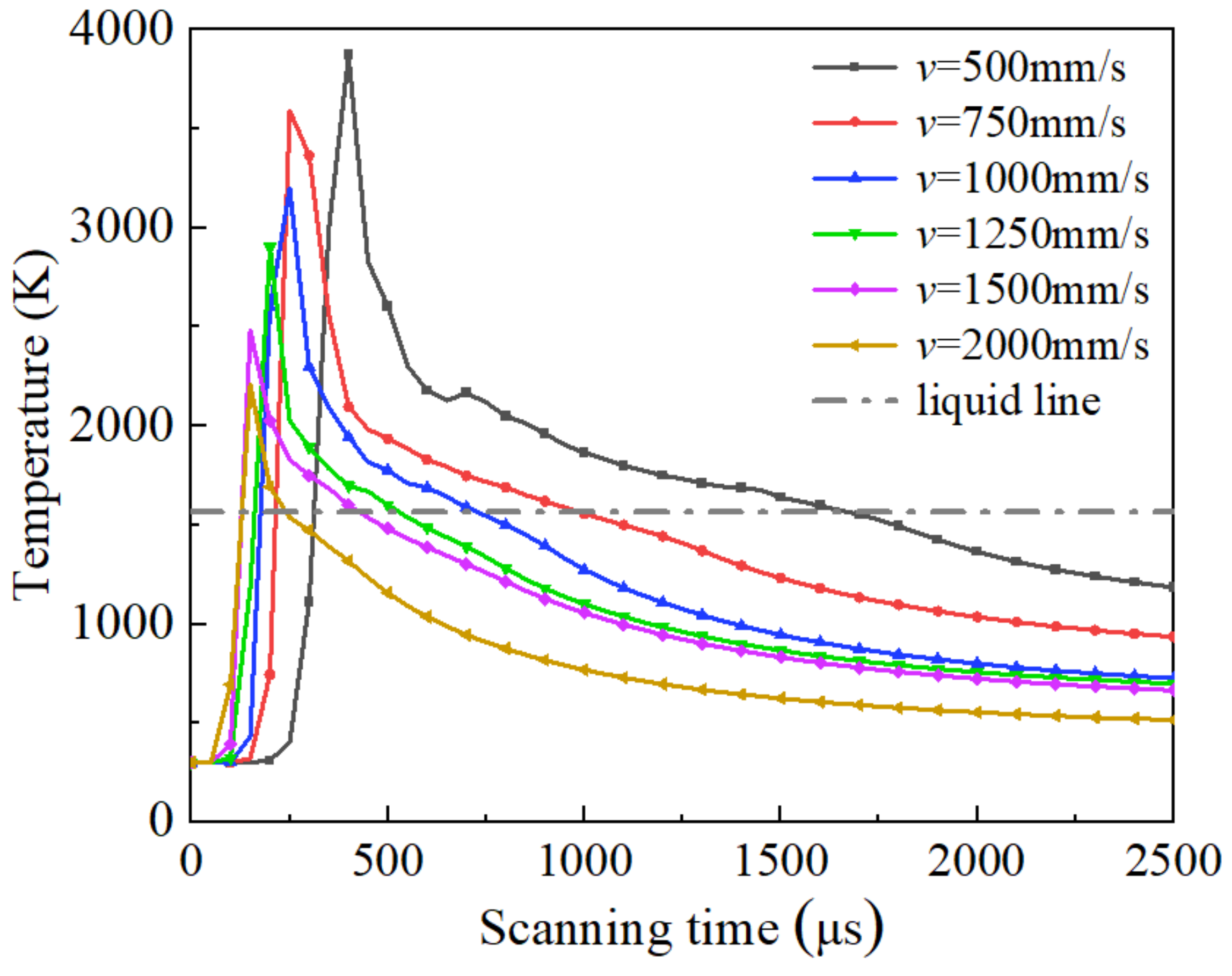
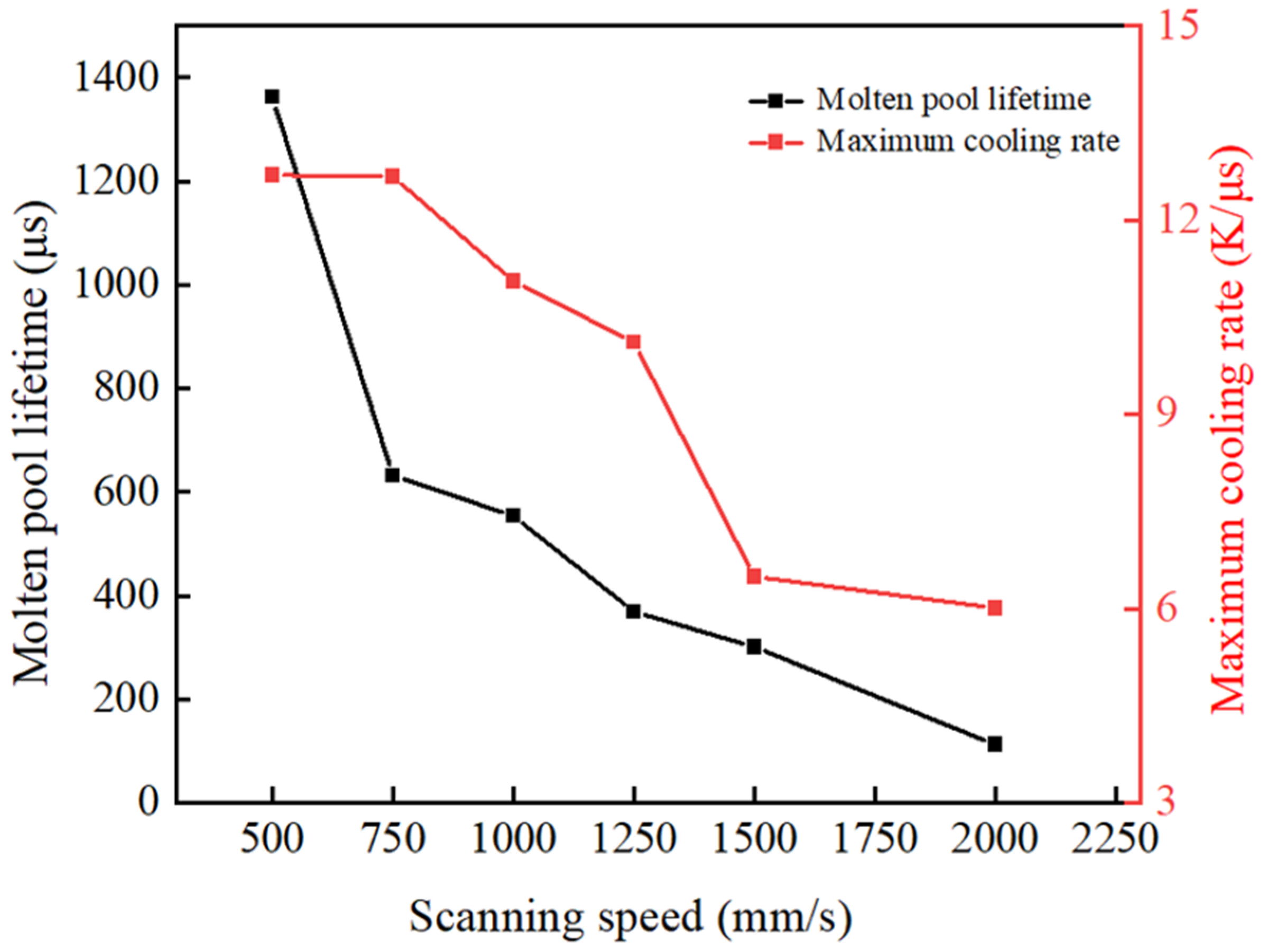
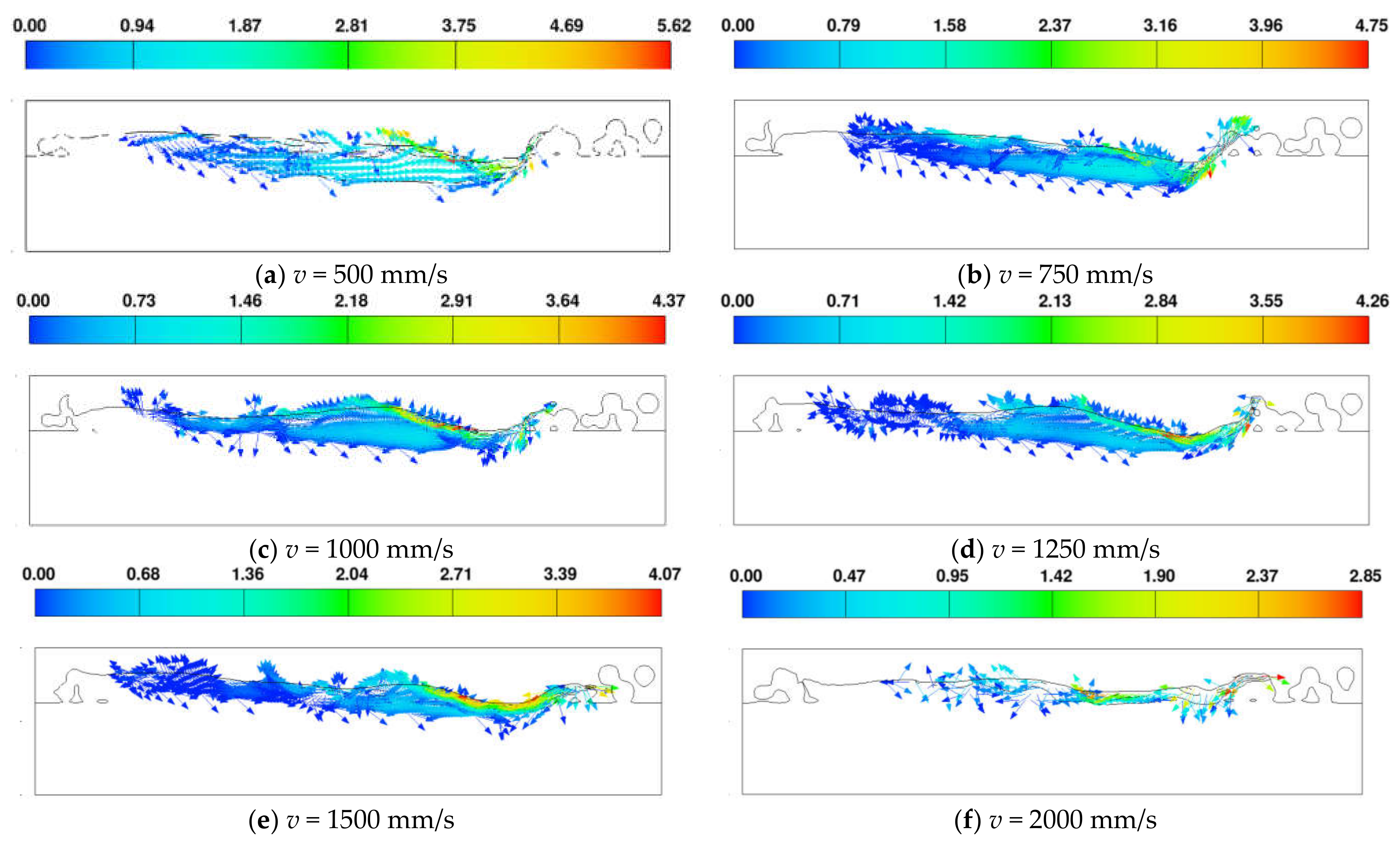

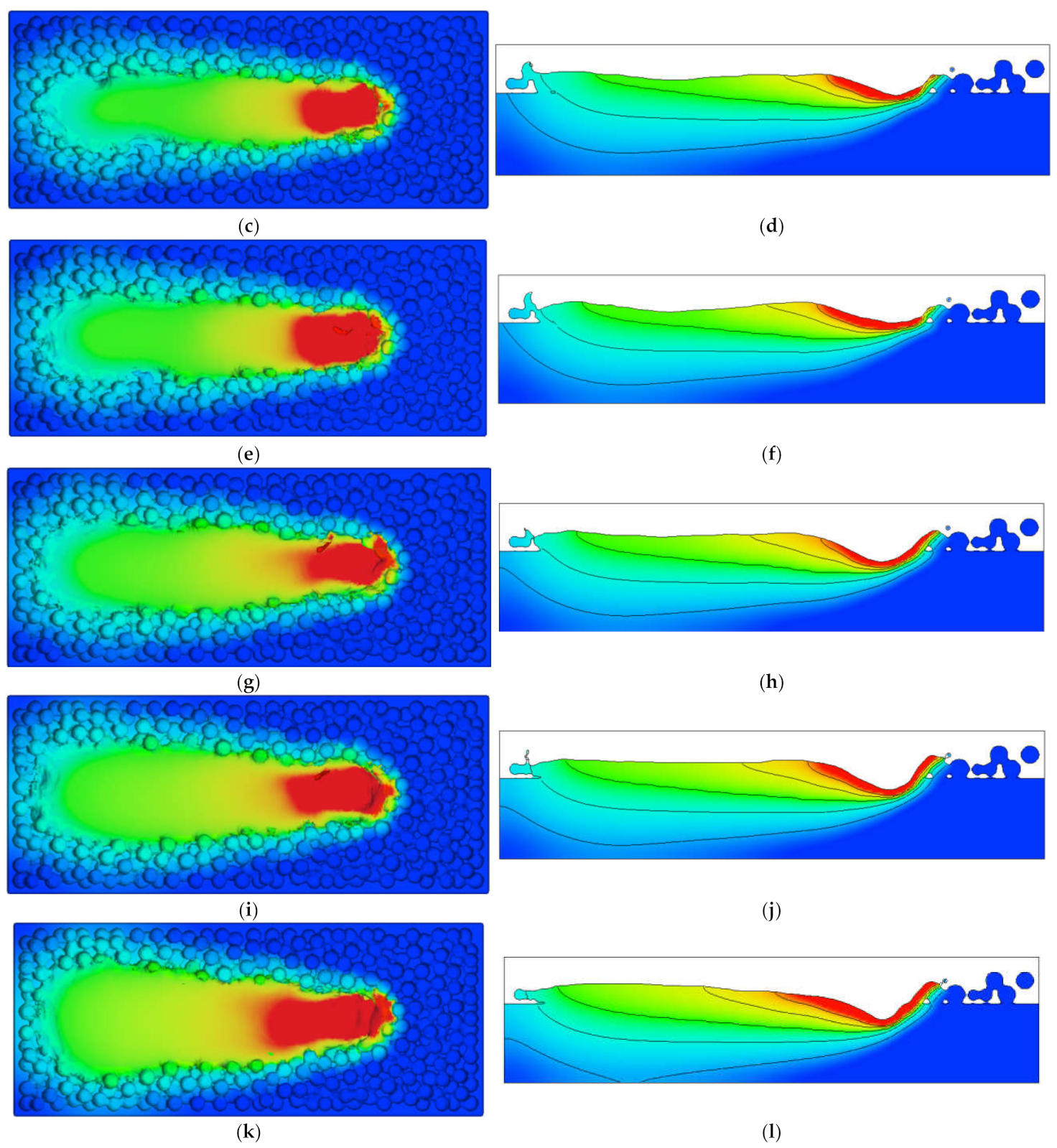
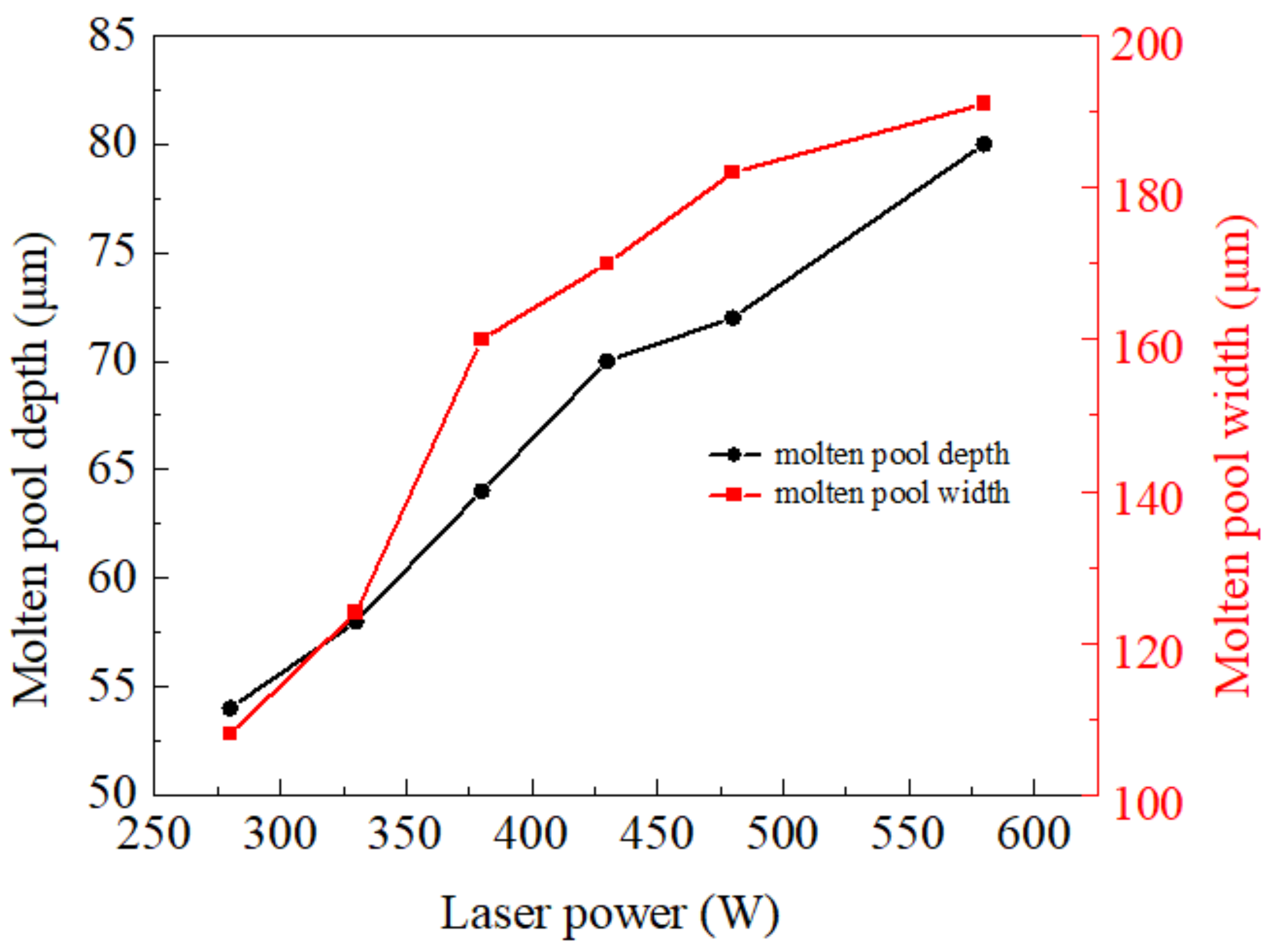

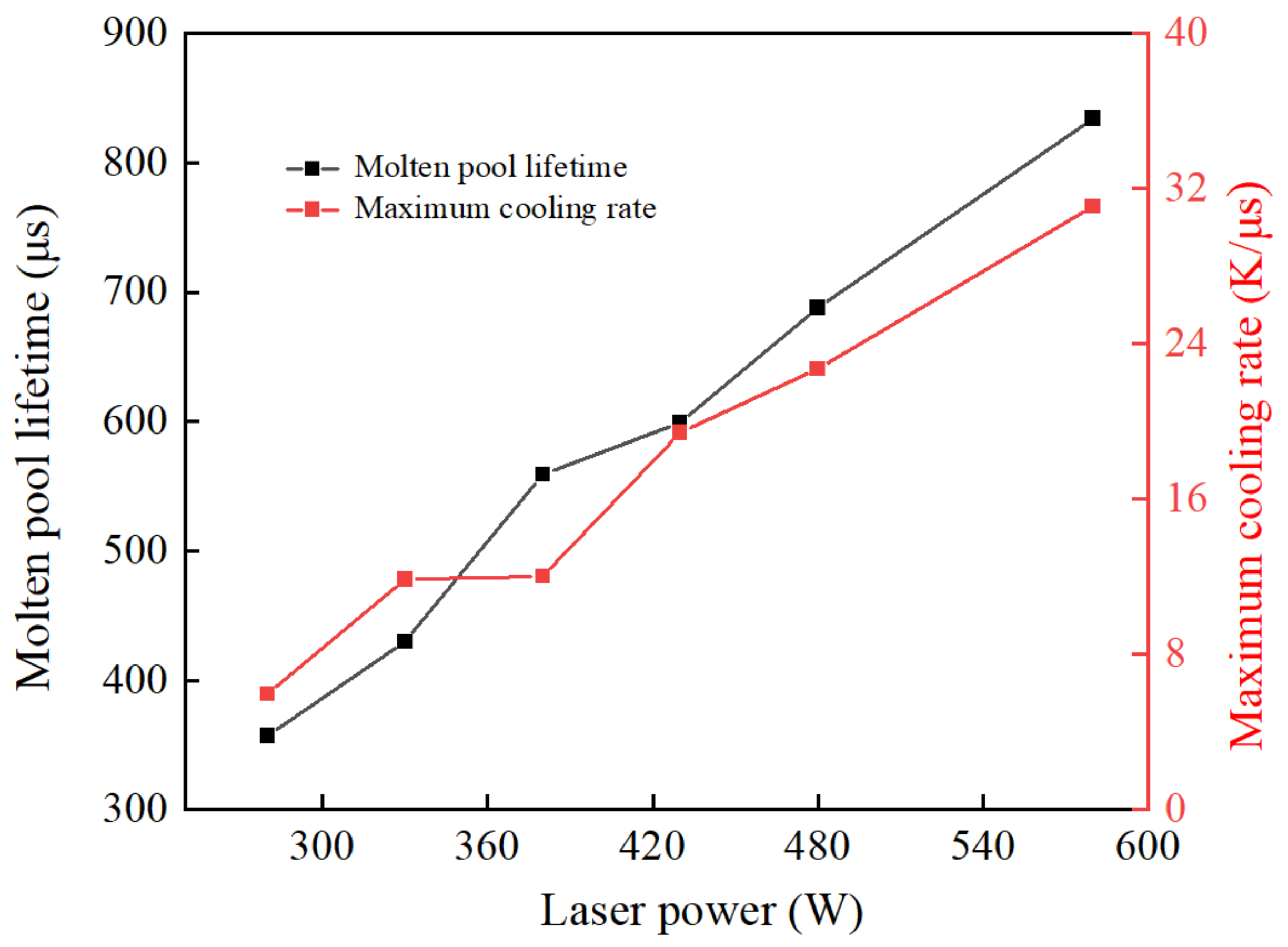
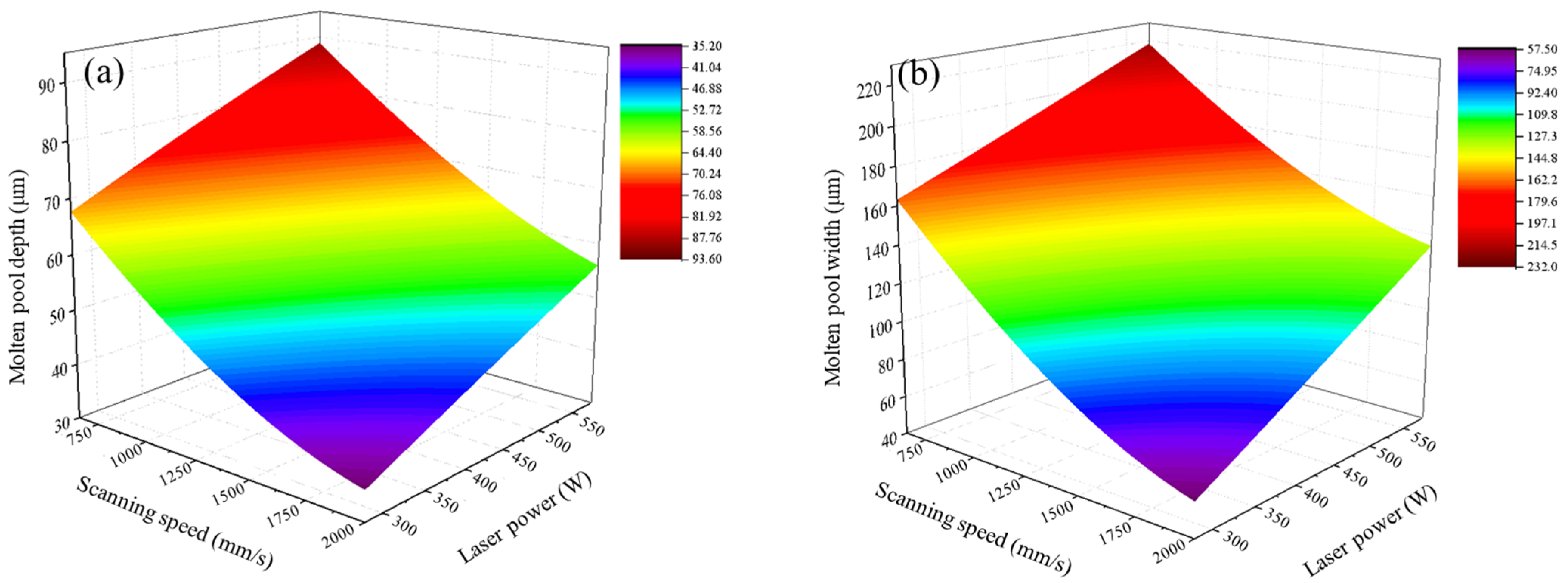
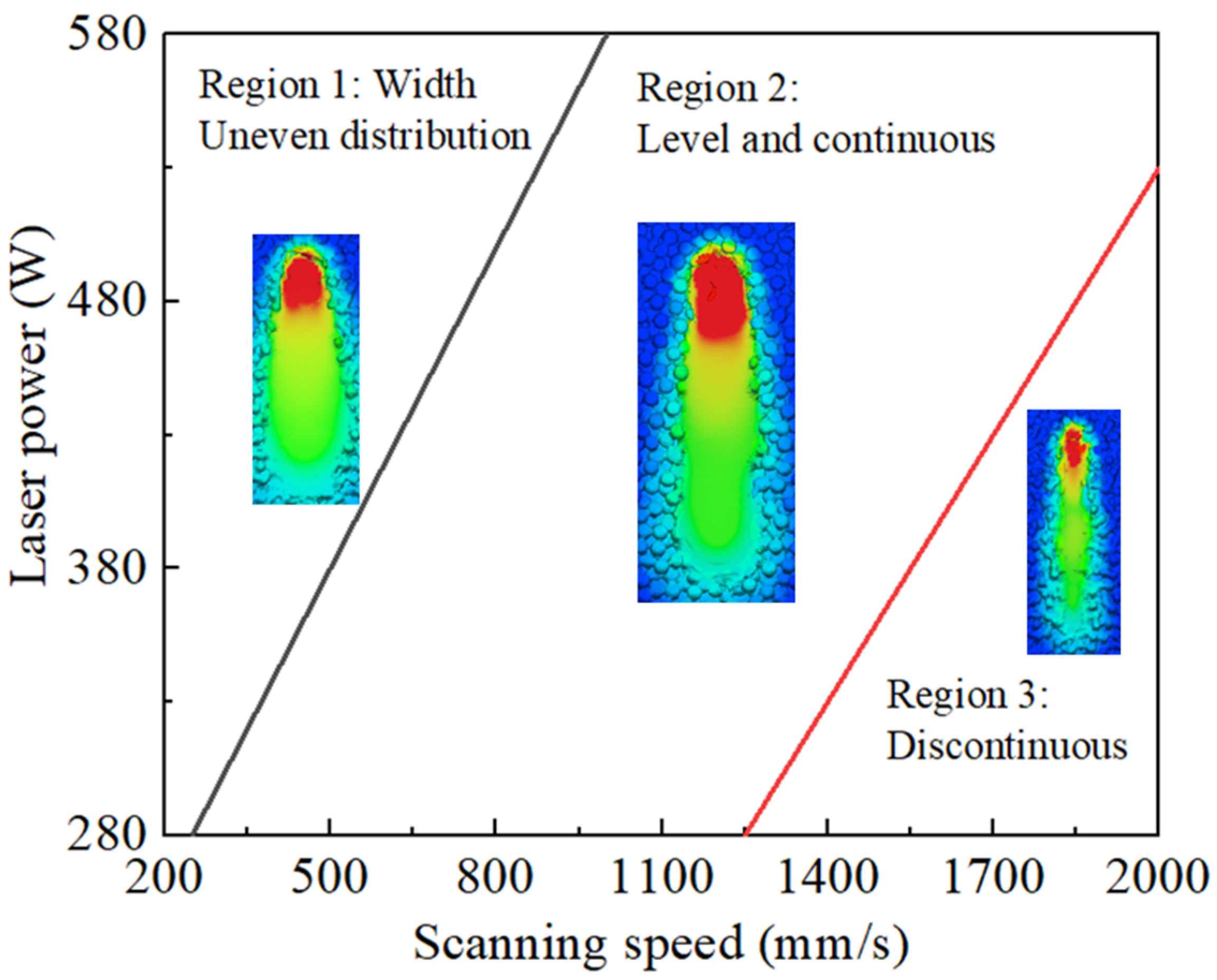
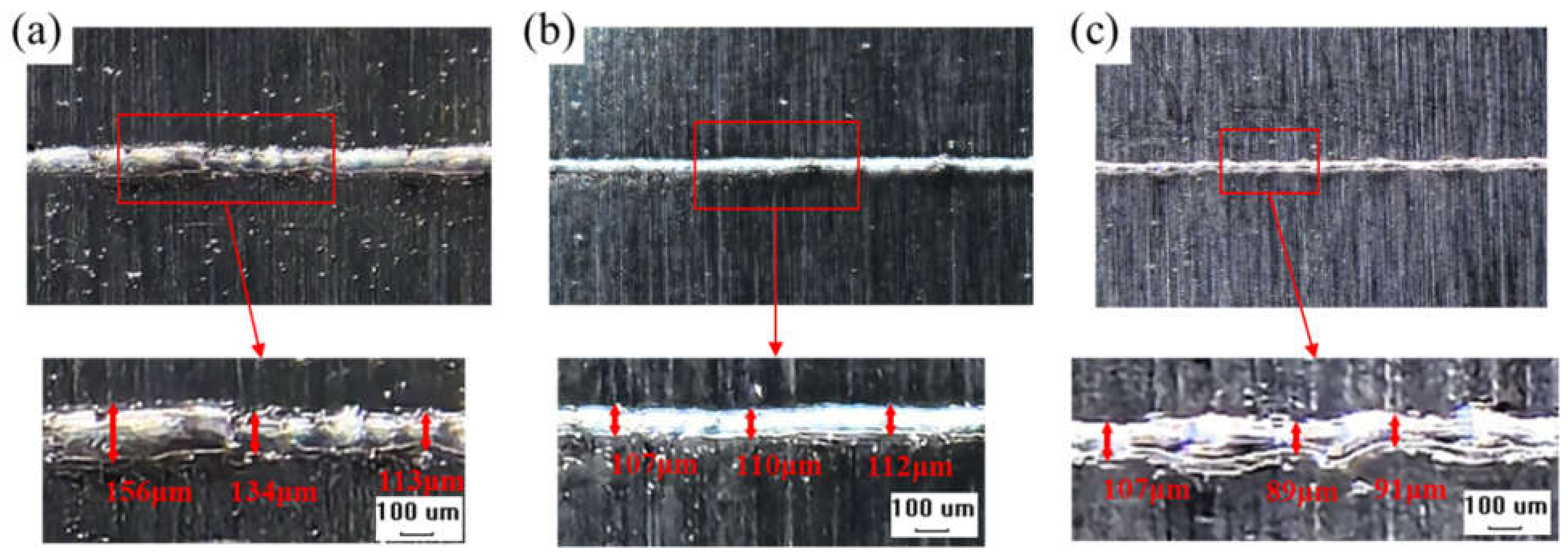
| Elements | C | Cr | Mo | Fe | Nb | Al | Ti | Mn | Co | Si | N | Ni |
|---|---|---|---|---|---|---|---|---|---|---|---|---|
| Content | 0.018 | 20.35 | 8.86 | 1.45 | 3.57 | 0.22 | 0.091 | 0.044 | 0.21 | 0.02 | 0.031 | Bal |
| Parameters | Value |
|---|---|
| Solidus temperature Tm/K | 1563 |
| Liquids temperature TL/K | 1623 |
| Boiling temperature Tv/K | 3000 |
| Surface tension at melting temperature γm/(mN/m) | 1906 |
| Temperature coefficient of surface tension dγ/Dt/(mN∙m−1∙K −1) | −0.37 |
| Effective enthalpy of metal vapor ΔHv/(erg/g) | 1.97 × 1010 |
| Convective heat transfer coefficient hcon/(W∙m−2∙K −1) | 80 [31] |
| Emissivity ε | 0.8 |
| Stefan–Boltzmann constant σs/(W∙m−2·K−4) | 5.67 × 10−8 |
| Laser power P/W | 280~580 |
| Scanning speed v/(mm∙s−1) | 500~2000 |
| Laser spot diameter d/μm | 100 |
| Laser absorptivity η | 0.38 |
| Ambient temperature Tref/K | 293.15 |
| Shield gas | Argon |
| Environment pressure p0/Pa | 700 |
Disclaimer/Publisher’s Note: The statements, opinions and data contained in all publications are solely those of the individual author(s) and contributor(s) and not of MDPI and/or the editor(s). MDPI and/or the editor(s) disclaim responsibility for any injury to people or property resulting from any ideas, methods, instructions or products referred to in the content. |
© 2024 by the authors. Licensee MDPI, Basel, Switzerland. This article is an open access article distributed under the terms and conditions of the Creative Commons Attribution (CC BY) license (https://creativecommons.org/licenses/by/4.0/).
Share and Cite
Quan, G.; Deng, Q.; Zhao, Y.; Quan, M.; Wu, D. Achievement of a Parameter Window for the Selective Laser Melting Formation of a GH3625 Alloy. Materials 2024, 17, 2333. https://doi.org/10.3390/ma17102333
Quan G, Deng Q, Zhao Y, Quan M, Wu D. Achievement of a Parameter Window for the Selective Laser Melting Formation of a GH3625 Alloy. Materials. 2024; 17(10):2333. https://doi.org/10.3390/ma17102333
Chicago/Turabian StyleQuan, Guozheng, Qi Deng, Yifan Zhao, Mingguo Quan, and Daijian Wu. 2024. "Achievement of a Parameter Window for the Selective Laser Melting Formation of a GH3625 Alloy" Materials 17, no. 10: 2333. https://doi.org/10.3390/ma17102333
APA StyleQuan, G., Deng, Q., Zhao, Y., Quan, M., & Wu, D. (2024). Achievement of a Parameter Window for the Selective Laser Melting Formation of a GH3625 Alloy. Materials, 17(10), 2333. https://doi.org/10.3390/ma17102333







